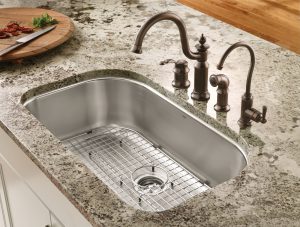
Modern kitchens come with modern surfaces and finishes so learning to clean them can be a daunting task. Here are a few tips for keeping your kitchen faucets and sinks clean.
FAUCETS
Faucets come in an array of finishes so keeping them clean helps protect those finishes. The easiest way to keep your faucet free from water spots is to blot it dry after use. If you have water spots use warm water and a soft damp cloth to wipe them off. Allowing water to evaporate on the surface can lead to build-up of mineral deposits.
If you have mineral deposits some manufacturers recommend using a 50/50 solution of white vinegar and water. If you use this make sure you rinse the surface thoroughly with water afterward and dry. Always check the use and care manual for the specific manufacturer of your faucet as this may damage some finishes.
Manufacturers may change their cleaning formulas at any time so be sure to test a small area if using a new cleaner.
Avoid using industrial cleaner, abrasive cleaners, green Scotch-Brite heavy duty scrub sponges, soft scrub, harsh abrasives or polishes, or other harsh cleaners or cleaning products. Avoid products that state on the label that they remove tarnish and rust, those containing hydrofluoric, hydrochloric, and/or phosphoric acids and caustic agents. Lastly, avoid using bleach-based cleaners.
GENERAL SINK CLEANING AND PROTECTION INFORMATION
All sink manufacturers recommend when using a new cleaner on surfaces that you should test in a small, inconspicuous area first. You should follow the use, care, and cleaning guides provided with your products to prevent voiding the warranty.
Most sink manufacturers also recommend that you clean the sinks daily and dry them after each use. Use a bottom basin rack or rinse basket to protect the sink's surface and that you run cold water when pouring boiling water in your sink to help protect it.
They do not recommend you use abrasive pads like steel wool or wire brushes as these can damage most sink surfaces.
They also recommend you do not store any open containers or household cleaners or chemicals containing chlorides such as bleach, acid, drain cleaners, or toilet bowl cleaners beneath the sink. Vapor emission from the chlorides can cause corrosion and pitting to the exposed stainless steel or other metals including faucet supply lines.
Dish mats are not recommended as they can trap soap, dirt making sink maintenance more timeconsuming and cultivate harmful bacteria.
Leaving standing water in your sink, especially if it contains anything that could stain the sink is also not recommended.
STAINLESS STEEL SINKS
Cleaning your sink after each use will help prevent the buildup of soap or mineral deposits. For daily cleaning use an ordinary mild detergent and a soft cloth to rinse and dry the sink. Allowing water and cleaners to evaporate on metal will negatively impact the look of the sink. To avoid water deposits from forming, wipe the sink with a soft cloth after each use.
Clean the stainless steel at least once a week following the manufacturer's use and care guide. Always apply stainless steel cleaner with a nonabrasive cloth or sponge, working with the grain, not across, the grain. You should never use steel soap pads, steel wool, or wire brushes: particles can adhere to the stainless steel surface and will eventually rust. If an abrasive pad must be used, Elkay recommends Scotch-Brite non-scratch (blue Scotch-Brite pad).
Light scratches are normal for stainless steel sinks, over time they will blend into the uniform finish pattern.
Do not use cleaners containing ammonia, bleach, or other harsh chemicals. Chemicals containing chlorides (bleach) can be damaging to the stainless. If used, rinse the surface immediately to prevent corrosion.
Kohler and Elkay recommend using Autosol Rust Remover or Bar Keeper’s Friend MORE Spray & Foam Cleaner to remove rust from stainless steel sinks.
QUARTZ SINKS
Just like most sinks, quartz sinks also recommend you clean them daily to avoid the build-up of soap and mineral deposits as these tend to have an adverse effect on the appearance of the sink. For daily cleaning use an ordinary mild detergent and a soft cloth to rinse and dry the sink. Allowing water or cleaners to evaporate in the sink will negatively impact the look of the sink. It is recommended that you dry the sink after each use. Soft abrasive cleaners may be used when necessary with (Blue Scotch-Brite Pads)
On quartz sinks, you can remove stubborn stains and watermarks with the eraser pad included with some manufacturers cleaning kits or a Mr. Clean® Magic Eraser® or a 50/50 white vinegar and water solution. Towel dry with a cotton cloth.
To restore the shine of your quartz sink, apply 1 to 2 teaspoons of mineral oil to a clean, dry cloth. Evenly distribute the oil in a thin layer and allow it to sit for about 2 minutes, and then wipe away any excess. Major stains can try using a mixture of a half cup of white vinegar and a half cup of water. Dip a cloth into the solution and rub away the grime or stain. The solution should be rinsed off and dried to prevent damage to your sink’s finish. For major grime or stains, you can also tray a small amount of baking soda and water on a toothbrush. This should remove any nasty stains. Again the solution should be rinsed off and dried to prevent damage to the finish of your sink.
Do not allow any part of your sink to soak in either of the above mixtures. It is still recommended that you text the above mixtures on an unseen part of your sink to see what effect it has on the finish of your sink.
CAST IRON SINKS
For daily care, Kohler recommends Kohler Cast Iron Cleaner and for rust removal, they recommend Bon Ami or Super Iron Out Rust Stain Remover. Please follow the manufacturer’s directions.
Article By Plumb Supply Kitchen & Baths
920 SE Frontier Ave
Waukee, IA 50263
(515) 987-2802
www.pskitchensbaths.com

